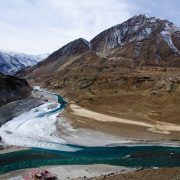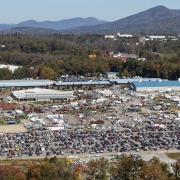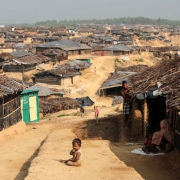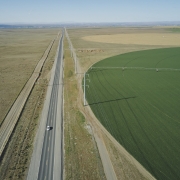Landmark Klamath Basin Water Agreement Is on Verge of Collapse
Congress could allow year-end deadline for review and enactment to expire.
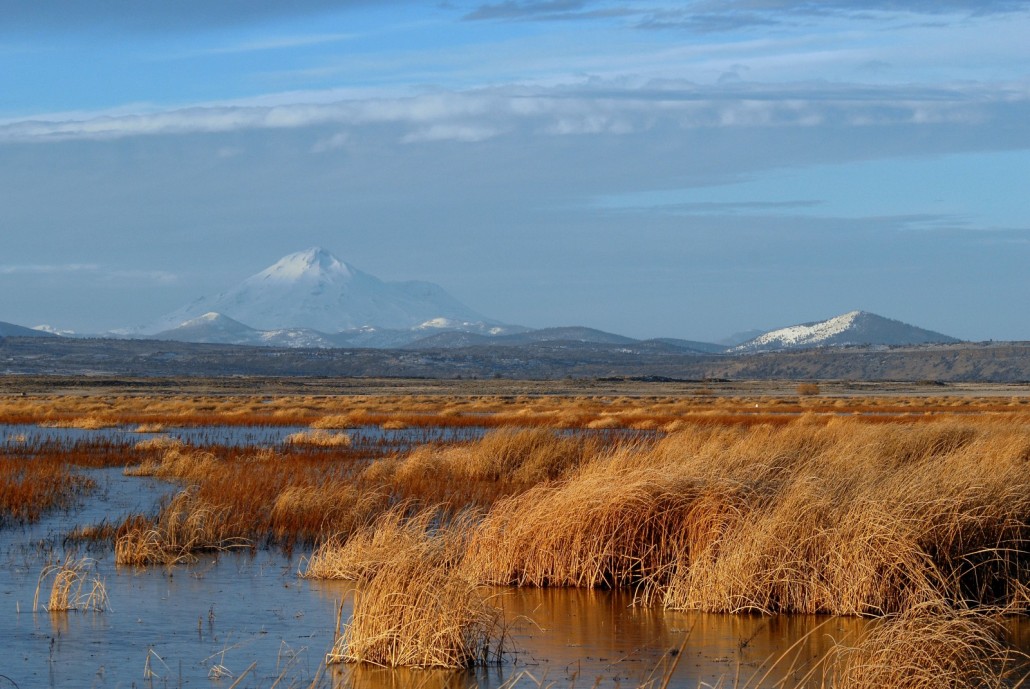
Tule Lake National Wildlife Refuge is one of six national refuges in the Upper Klamath River Basin. A comprehensive water deal in the basin will guarantee water for the refuges. Photo © U.S. Fish and Wildlife Service
By Brett Walton, Circle of Blue
On July 14, 2001, pulses quickened in Oregon’s Klamath River Basin when unarmed U.S. marshals were summoned to stand guard over irrigation water gates that until that day had never needed such protection. In defiance of federal orders, protesters sympathetic to farmers opened the gates with cutting torches and chainsaws to release water into canals that watered alfalfa and potato fields.
The crowd of more than 100 protesters objected to the federal Bureau of Reclamation’s decision to drastically reduce irrigation deliveries from Upper Klamath Lake. In a drought year, there was not enough water to meet all demands. At the same time, environmental groups and Indian tribes were beginning to advocate for the removal of four hydropower dams downstream to boost salmon runs. If approved, it would be the largest dam removal project in U.S. history.
“People are already looking at Plan B.”
–Greg Addington, executive director
Klamath Water Users Association
The Klamath protesters were reacting to the consequences of a 1999 federal appeals court decision in an Endangered Species Act case that seemed to tilt the balance of water use and demand in the upper basin in favor of fish, not farmers. The federal court ruling directed the agency to preserve water for the endangered shortnose sucker, Lost River sucker, and the threatened coho salmon.
“There is a lot of anger,” a farm equipment dealer in Klamath Falls, the town adjacent to the lake, told the Associated Press. The next day, the New York Times editorial board called the crisis in the Klamath “Oregon’s Water War.”
Though tensions ran hot in the summer of 2001, a water war did not break out. Instead, the basin’s feuding interest groups accomplished a task less thrilling but much harder and more significant: they compromised. Ranchers, farmers, Indian tribes, dam owners, commercial fishing businesses, environmental groups, and local, state, and federal agencies acknowledged that the old ways of using water were broken. Farms could not use all the water they were accustomed to. Degraded streams would have to be repaired and more water left in them. The basin could not continue its former path of lawsuits and recriminations.
Signed in 2010 and expanded in 2014, the three Klamath agreements were hailed as a model for watersheds that must realign water supply and demand. The three agreements, amounting to the largest watershed restoration project in the West, covered federal lands, funding, and water rights that require Congressional review and approval. But if Congress does not pass a bill by December 31, 2015 that authorizes the new management practices in the package and provides funding to facilitate the transition, three Indian tribes that are party to the agreements have indicated that they will pull out because of inaction.
The deadline is fast approaching. If Congress does not approve the measures, lawmakers will, in effect, scuttle a hard-won settlement that, through many years of negotiation, transformed one of the most bitter water feuds in the American West into a nationally significant model of compromise and collaboration. Republican lawmakers, who are ideologically opposed to several of the agreement’s provisions, especially the clause calling for removing the four hydropower dams on the Klamath, have not considered the agreement with the urgency that their constituents would like.
“I’m very concerned,” said Greg Addington, executive director of the Klamath Water Users Association, which represents farmers and ranchers who hold irrigation contracts with the federal government and is a party to the agreements. “We put a decade worth of work into crafting the agreements and trying to get legislation passed. If we don’t get a bill passed, I don’t know what will happen. But the agreements as we know them will go away.”
“People are already looking at Plan B,” Addington added in an interview with Circle of Blue. “They’ll go back to the old ways — hardball, lawsuits, political negotiations — the things we tried to avoid with the agreements.”
Waiting on Congress
The Klamath River rises in the sagebrush and rangelands of southern Oregon and flows west 400 kilometers (250 miles) before meeting the Pacific Ocean near fog-shrouded Crescent City, California. The basin’s political geography is just as varied, bridging conservative ranchers in Oregon and liberal environmentalists on the coast.
The Klamath Basin agreements address water rights, stream restoration, a tribal land swap, and the revival of what used to be the third largest salmon run on the West Coast. Most controversially, the agreements define a process for the largest dam removal project in U.S. history: tearing down four hydropower dams on the river’s main stem that are owned by PacifiCorp, an electric company. Removing the dams would reopen 675 kilometers (420 miles) of spawning grounds in the river’s upper basin that have been closed to migrating salmon for nearly a century.
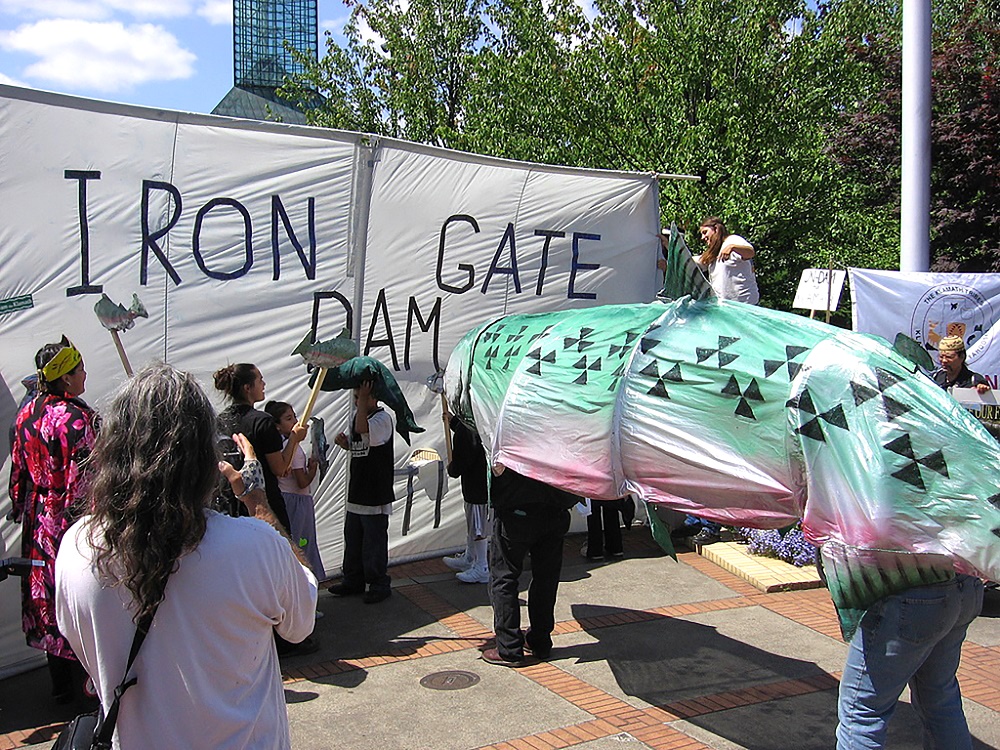
Members of the Klamath Basin Tribes and allies from commercial fishing and conservation organizations stage a rally in support of removing four hydropower dams on the Klamath River. The rally was held on August 2, 2006, in Portland, Oregon, at Hydrovision, the biannual meeting of the international hydropower industry. Photo © Patrick McCully / Creative Commons
Few observers thought that such a circus of competing interests — at that point all enmeshed in lawsuits — could set aside their grievances and broker a deal. They did, though the deal is not unanimously endorsed by all groups. Moreover, the agreement required Congressional review and approval to changes in how the Bureau of Reclamation operates the Klamath irrigation project. Other programs, such as the stream restoration and tribal economic development require federal funding to get off the ground.
Recognizing that support for such a far-reaching agreement could unravel, negotiators in 2012 added an exit clause in case Congress dithered. The three Indian tribes that signed the accords — the Klamath, Karuk, and Yurok — exercised that option, giving notice earlier this year that they would back out of the deal if Congress did not pass a bill by the end of 2015. Tribal officials say that the benefits that they bargained for — a land deal for the Klamath Tribes, improvements to fish habitat, and more water for rivers — will not materialize without legislation.
“The tribes and fisheries can’t wait forever for Congress to have a change of heart,” Craig Tucker, natural resources policy advisor to the Karuk, told Circle of Blue. “House Republicans have had plenty of opportunities to understand and study the issues. If they are not moved yet, I don’t know why they would have a change of heart.”
Those in the basin who support the agreements are hopeful that the representatives will learn from their constituents and work out a deal. There’s real urgency to doing so. The reservoirs burst with toxic algae during the hot, dry summer of 2015. Water deliveries to irrigators and groundwater levels that are used as a substitute are declining. The threat of more disease outbreaks in salmon stocks is always present.
A History of Conflict
By nearly all accounts, the Klamath agreements, which were signed by more than 45 parties, are a monument to pragmatism and reason in the long history of water conflict in the American West.
“It’s a tremendous achievement that the parties brokered a deal and stuck together,” Matt Bond told Circle of Blue. Bond is a spokesman for the U.S. Fish and Wildlife Service, which is a party to the agreements. “We’ve had peace in the Klamath over the last five years. Former litigants came together and put litigation on hold. That’s a big achievement in four years of drought and ecosystem stress.”
The tenuous peace was preceded by more than a decade of bitter feuding that stemmed from a disruption in the established water order. Legal decisions in the 1990s allocated more water for the basin’s depleted fisheries. Farmers, accustomed to first claim on the water, were no longer at the top of the pecking order.
In 1999, the U.S. Court of Appeals for the Ninth Circuit ruled that irrigation water deliveries from the Bureau of Reclamation’s Klamath Project, a federal irrigation system established in 1905 in southern Oregon, were a lower priority than three fish protected by the Endangered Species Act: shortnose sucker, Lost River sucker, and coho salmon.
The new legal guidance was tested in April 2001 thanks to a drought and a lawsuit filed by commercial fishing interests. The Bureau of Reclamation cut off irrigation water deliveries to nearly 1,400 farms for most of the spring and summer, opening the canal gates for only a few weeks in July and August. Protesters cut the locks on the irrigation gates to allow water to flow, and farmers promptly sued, claiming that water restrictions were an unauthorized taking of their property and they were owed compensation. The case is still in appeals.
Ecological conditions deteriorated the next year when irrigation deliveries resumed. In the last two weeks of September 2002, an estimated 33,527 fish, 97 percent of which were Chinook salmon, died in the lower Klamath as they returned to spawn, according to the U.S. Fish and Wildlife Service, which acknowledged that the estimate was conservative. The salmon died from a disease spread by Ich, a protozoan, and columnaris, a bacteria. The unwelcomed biological duo multiplied in an environment ideal for a lethal outbreak: crowds of fish massed in warm, stagnant water.
Another warning bell sounded in 2006 when commercial fishing along a 1,125-kilometer (700-mile) stretch of the California and Oregon coasts was severely restricted to protect salmon stocks. At that point, the number of returning Chinook salmon was down more than 90 percent from the 1920s.
Then in 2013, after the Oregon Water Resources Department declared that Native Americans have the highest priority on the tributaries that feed Upper Klamath Lake, the Klamath Tribes made a first-ever “call” on their water rights to protect upper basin fisheries. Irrigators saw their water supplies diminished yet again.
From this cauldron, the Klamath agreements arose. Every side made concessions. The tribes agreed not to pursue their historic rights to the Klamath River, which would disrupt irrigation deliveries. Irrigators, seeking more certainty, gave up a portion of their accustomed water allocations to be used for ecosystem restoration. Irrigators also guaranteed an annual water supply for national wildlife refuges in the upper basin. Today, the refuges are last in line for water. They are not guaranteed supply.
Dams Block Action Needed by Congress
Though signed by dozens of parties, many of the key provisions in the Klamath agreements require authorization or funding from Congress. Congressional approval is needed for a land deal that will transfer 40,365 hectares (99,745 acres) of the Fremont-Winema National Forest to the Klamath Tribes. The forest is part of the tribes’ former 728,000 hectare (1.8 million acre) reservation that Congress dissolved in 1954. Lawmakers also need to provide $US 40 million in economic development funds, which are part of the agreements, to the Klamath Tribes.
Further approvals are needed. Congress must change the purpose of the Bureau of Reclamation’s Klamath Project to include water for wildlife refuges. Congress must give the Secretary of the Interior the authority to decide whether to remove the dams. Federal legislation would also shield PacifiCorp from lawsuits after the dams come down.
The federal government is not paying to remove the dams, three of which are in California and one in Oregon. $US 200 million will come from PacifiCorp’s customers and $US 250 million from bonds sold by the state of California.
The Clock Ticks
The House of Representatives is scheduled to be in session only 16 more days in 2015. Supporters of the Klamath agreements worry that every day without a bill is a lost opportunity.
Circle of Blue asked Sen. Ron Wyden (D-OR), Rep. Greg Walden (R-OR), and Rep. Doug LaMalfa (R-CA) for comment. In January, Wyden introduced Senate Bill 133, which will implement the agreements. Similar legislation sponsored by Wyden in the last session of Congress failed to move out of the Senate.
Walden and LaMalfa represent districts that overlap the Klamath Basin. Both have been critical of dam removal and are key players in any legislation. Walden has suggested in interviews in recent weeks that he will consider introducing a bill before the end of the year.
Only Wyden responded to Circle of Blue’s request. His press secretary wrote in an emailed statement that Wyden “remains committed to working with all interested parties who have worked for so long to come together to find common ground.” He would not elaborate on the bill’s obstacles, the consequences of inaction, or the likelihood of success.
“It’s a sad tale if the agreement ends here,” said Tucker, who advises the Karuk tribe. “Our congressmen challenged communities to bring a solution, and we did. Yet they can’t hold up their side of the deal. Any other time in American history if you had a coalition as broad as ours, people would leap for joy.”
Don Gentry, chairman of the Klamath Tribes, remains hopeful even as the deadline approaches.
“I’m optimistic that Congress can resolve this,” Gentry told Circle of Blue. “I hate to think about what the future will be if it doesn’t. I hope folks in Congress will see that this is a local solution by local parties. It’s not necessarily all that we want but the settlement is something that we can live with.”
Brett writes about agriculture, energy, infrastructure, and the politics and economics of water in the United States. He also writes the Federal Water Tap, Circle of Blue’s weekly digest of U.S. government water news. He is the winner of two Society of Environmental Journalists reporting awards, one of the top honors in American environmental journalism: first place for explanatory reporting for a series on septic system pollution in the United States(2016) and third place for beat reporting in a small market (2014). He received the Sierra Club’s Distinguished Service Award in 2018. Brett lives in Seattle, where he hikes the mountains and bakes pies. Contact Brett Walton



